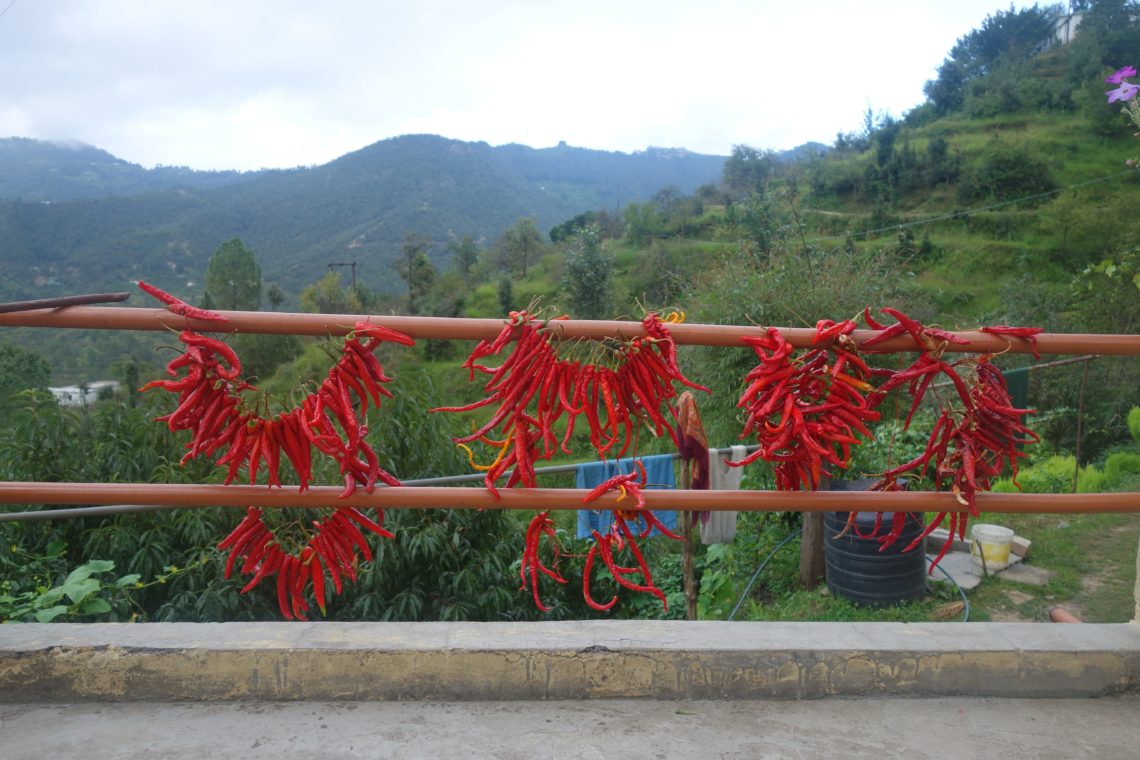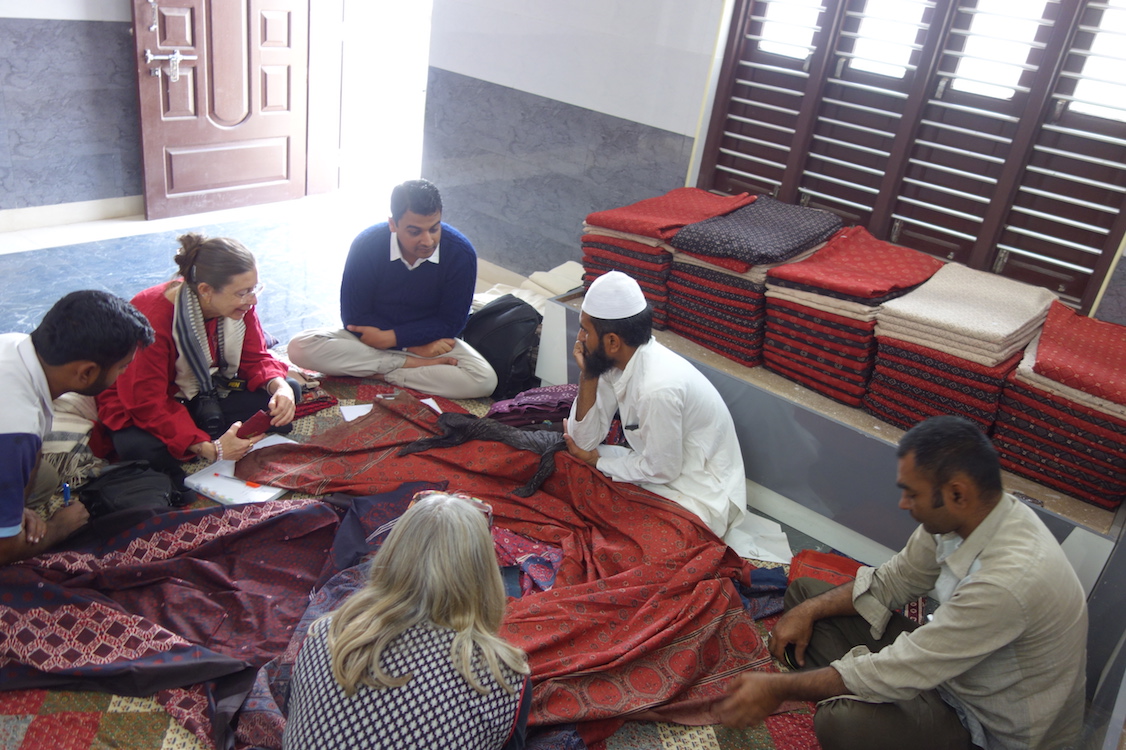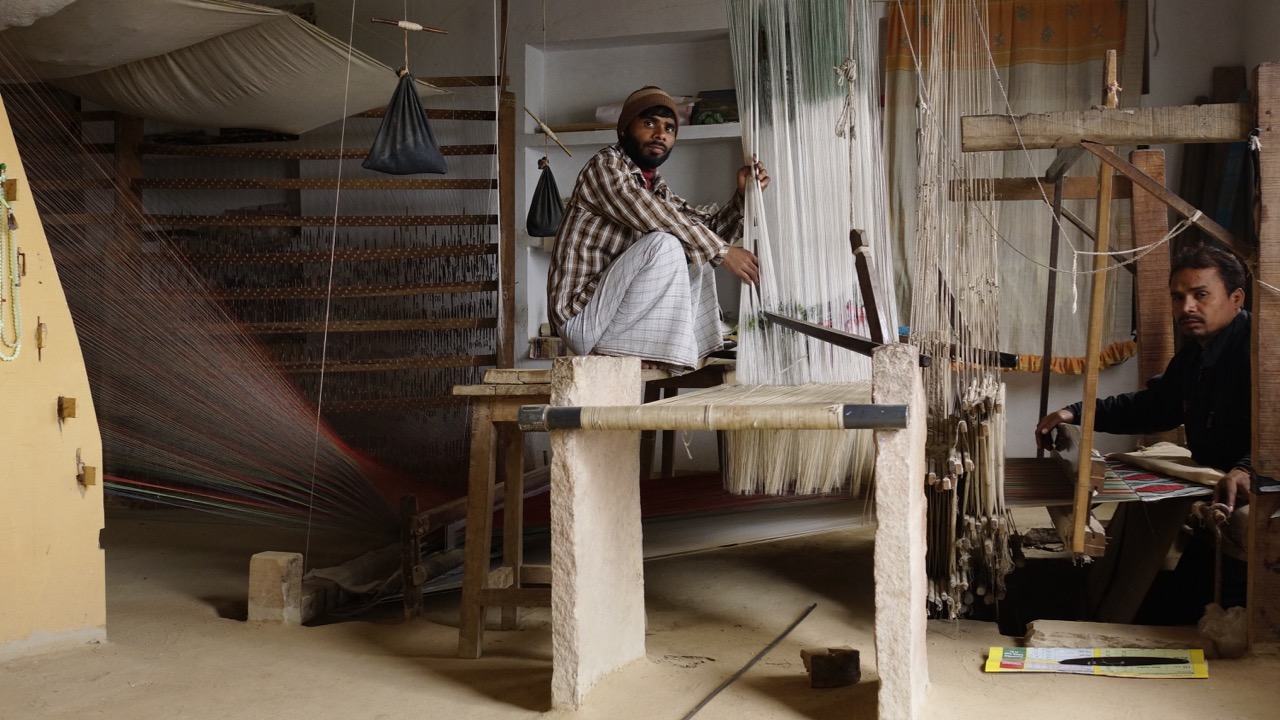The mountains of North India are a perfect getaway from the bustle, pollution and heat of the cities. And you can easily reach them from Delhi. I travelled up to the small village of Kasiyalekh in the Himalayan foothills, in the state of Uttarakhand to visit a social enterprise called Kumaun Grameen Udyog (KGU). I took a 5 hour train from Delhi to Kathgodam (you can go from here or the near-by larger town of Haldwani) and then a bus which skillfully wound its way up the steep and narrow lanes running up the mountain for about three and a half hours. I was greeted at the bus stop at Kasiyalekh by one of the employees of KGU, and the office was just a few yards away. I met Bahadur, the office manager and Rajendra Singh Jeena, popularly known as Jeenaji. Jeenaji told me he has been associated with KGU since its inception. He learnt weaving at a technology institute in Almora and came to KGU to teach local people weaving.


Jeenaji accompanied me 2 kms down the road to the home I would be staying at for the next few nights. A simple beautifully positioned 3 story building overlooking the valley and home to Dikar, a weaver at the centre, his wife and three children, brother and his brother’s wife and child and their parents. The upper balcony was lined with flowers and plants in re-used plastic tubs, framing the hilly landscape view. Dikar’s mother was preparing rajma (kidney beans), one of the many local crops of the region. I freshened up in the simple outdoor bathroom, which you cross the cow paddock to reach, noticing the softness of the mountain water, and was ready to visit the weaving centre.

KGU was set up as a section 25 company in 1996 by NGO Chirag (Central Himalayan Rural Action Group) that was started 30 years ago to implement health and education initiatives in the region. Eventually CHIRAG saw that there was a need for livelihood development as farming became more of a struggle. Agriculture is the main source of employment in the area, but the change in climate has caused a decline. Further, all agricultural workers are completely dependent on middlemen in Haldwani who are always trying to cut the costs and pay as little as possible. Different houses own different nallis of land. Fruit is the main crop and the main harvest is just once a year. There is also rajma – beans, and wheat. Vegetables such as cabbage and cauliflower have been introduced.
Further down the hill near to the small hamlet of Buribana, you reach KGU’s weaving centre. It is spread across three small buildings on different levels following the hill’s contours. There are three workshops. In the first, at the time I visited, there were 4 looms all operated by women. Walking through here and out the other side, walk up the steps and you reach another room with the warping mill and a desk where Ravi, the quality checker sits, and there’s also one small sample loom. Ravi said he keeps a record on the attendance of weavers and maintains a monthly report. Each weaver has to sign in and out. The hours are 9am to 5pm, but weavers get paid by piece so its up to them when they arrive and if they’d rather work less hours they can and make it up other times. There is an hour for lunch and a morning and afternoon short tea break. Up more steps and on the left is another weaving room above the one the women were in. This has 8 looms all positioned quite closely together.

Here I met Dikar, my homestay host. He was weaving a stole which had 800 yarns in the ground blue colour, 85 in each border and there were 40 ends per inch. I also met Vijay who is a graduate of The Handloom School in Maheshwar. Vijay was weaving running fabric in a diamond twill pattern. It was 40 threads per inch, 48 inch width in merino wool. The wool comes from Ludhiana – ready spun and dyed. The loom had 6 shafts and pedals. In the third workshop there are 6 more looms, being operated by men. Two women Rekha and Indra were preparing the looms. As there is no traditional labour division, all weavers work on all tasks including warping, denting, filling bobbins etc. The yarn is commonly 2/48 count in the warp, and 1/48 count in the weft. In addition to merino wool from Ludhiana, they also weave with matka silk and sometimes linen. In the first 6 months of the training, they learn warping and denting.


Kilmora is the brand name of the products produced at KGU. Along with training weavers, they work with local women knitters, a craft much more common in the region. They hold weekly workshops for them at the head office. Then there is the cosmetic products made with local produce such as apricots, sold at Kilmora’s shops in the region.

The next day I visited the KGU office at Kasiyalekh, to meet Sarika, the managing director. Sarika has been working at KGU for three years and before that has worked with a variety of social and non-profit organizations. She is a graphic designer and graduate of the National Institute of Design in Ahmedabad. Looking through the piles of stock kept in a large room within the office complex, I asked Sarika, if there’s no distinct traditional design vocabulary in the area, where do the designs come from? She answered that contemporary design is Kilmora’s USP. They follow trends and forecasts and have interns working on projects.
Jeenaji started with just 2 looms. The first orders were produced in Almora and as the orders increased they increased the number of looms in Buribana. Fabindia is Kilmora’s biggest buyer. Anokhi and Jaypore.com are some other clients and they exhibit at various exhibitions in Delhi such as Dastkar and Dilli Haat and various other cities. Kilmora has three retail stores in Uttarakhand- in Sagarket near Mukteshwar, in Sitla which is also their oldest shop – where Chirag started its operations, and in Kasar Devi, Almora. These are all geared towards the tourist market – which has risen significantly over the last few years.
The criteria for weavers joining the weaving centre is that they have to be economically disadvantaged and within walking distance from the centre. There are 25 full time weavers and around 250 knitters who mainly work from their home but come in once a week for training. Everyone is paid on a piece-rate basis. There are four people working on finishing and quality checking. The pay for weavers varies depending on product and difficulty of technique. But for a shawl, for example, it can range from 140 – 180 rupees per piece.

KGU had worked with Women Weave in the past on weaving projects. When Women Weave started the Handloom School, they got in touch with Sarika asking if she could send any of their weavers to the school. It had to be within Women Weave’s criteria – so within this group Sarika approached the weavers and asked who was interested. Two weavers, Vijay and Upendra expressed interest. While Upendra didn’t complete the course due to health issues, Vijay returned with positivity and enthusiasm for starting his own business. He even invested in a loom
‘Weaving is a good occupation, Farming is low income and hard work, and the major problem is the market, which the government are not helping with.’ (translation of interview with Vijay, August 2016).
He added that working on his own would give him the chance to develop his own designs and orders. I wondered what impact that would have on Kilmora. Sarika said it was ‘completely fine’. In fact she would feel happy that one of KGU’s weavers was progressing and becoming an entrepreneur. But at the time of my visit Vijay was experiencing difficulty setting it up. He had combined the settings of a Kilmora loom with a Maheshwar loom and it was causing problems. We discussed the difficulties with individual weavers setting up on their own in this non-traditional weaving region. In established weaving clusters where weaving has been practiced for several generations, they have the infrastructure for a weaving business – close proximity to couriers, a wealth of labour supply for various weaving tasks, easy access to raw material suppliers etc. Even Kilmora experiences difficulty with logistics and has to plan far ahead for timely to completion of orders.
Since my visit in August 2016, I have been informed that Vijay is still working hard to build his business, getting help with loom setting from Ravi, but struggling to bring in orders so continuing to work for Kilmora. If the region can receive more support from the government to improve infrastructure and market links, this along with the work of Kilmora, and institutes such as The Handloom School, will help to make Buri Bana become better known as a weaving region, continue to generate employment and help the region’s new weaving tradition thrive.







2 Comments
Leonore Alaniz
Dear Ruth, you so generously offer to help textilers with their travels. Have you thought of being a liaison between makers and designers who would like to work with indigenous artisans? I am personally interested to buy cloth from them. And so are others. Pl allow me to send you the link to an event helc in NYC that makes the point.
http://www.edelkoortinc.com/seminars-new-events/2017/5/3/talking-textiles-2017
“Textiles have the power to rekindle our faith in humanity. They bring together the fabric of culture through the crafted techniques that have been passed on throughout history. Whether it’s in the ceremonial dying of a natural yarn, the wearing of an embroidered veil or the upcycling of a discarded piece of trash, this year’s Talking Textiles Conference shows us how the loom can truly take materials to another level. come join 8 inspiring speakers from around the world to see the spirituality in textiles.”
The work of Angel Chang (one of the presenter) desrbes what is possible.
http://angelchang.com/blog/2015/07/ is one of the speakers
You may enjoy learning about the now global movement with which textilers organize regionally:
Fibershed.org .Would you help interested buyers connect with artisan weavers who look for buyers/ collaborators? I know this is not your aim, however, any link can strenghtens the web of life. Much is a stake. Otjers describe it well in the links enclosed. Have safe travels! With gratitude, Leonore Alaniz.
Dear Leonore,
Really pleased to hear from you again, and thanks for the links. Its interesting you mention helping artisans and buyers/collaborators connect as it is something I’ve been thinking of for a while. I’m currently in the later stages of my PhD and hope to pursue this plan further once the thesis is almost done. If you want to send me more details of the kind of cloth you’re looking for, I can put you into contact with some artisans. My email address is: ruth@travelsintextiles.com.
I was at a conference where someone from Fibreshed presented and found their work really interesting. Also, the conference link you sent looks great and wish I could attend but I’ve got a busy month in London. Will keep my eye out for future events.
Thanks again, and I’ll keep in touch with my plans and progress!
Best wishes,
Ruth